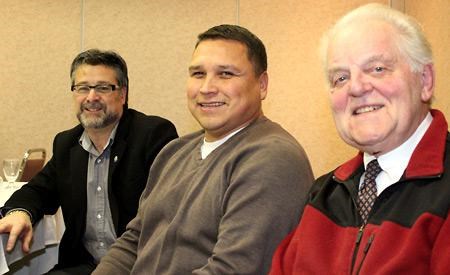Powell River’s local government officials pledged to cooperate with Tla’amin (Sliammon) First Nation as it prepares for the implementation of its treaty.
Tla’amin elected officials and staff, along with elected officials and staff from the City of Powell River and Powell River Regional District, met at a community-to-community forum on Thursday, January 24 at Powell River Town Centre Hotel. The two-hour event was hosted by the regional district to promote good communications and included lunch.
In July 2012, a majority of Tla’amin members voted to accept the final treaty agreement with BC and Canada.
BC is expected to table the legislation sometime in February, then it will be introduced in Parliament for debate. Once it is enacted through federal legislation, which is expected in the fall of 2013, an effective date will be established.
The treaty includes provisions for self-governance, approximately 8,322 hectares of treaty settlement lands, treaty rights to harvest natural resources, including fish and shellfish, wildlife, migratory birds and plants, community forest tenures, aquaculture tenures, freshwater licences, fish and wildlife management, cultural and heritage stewardship, resource revenue sharing and cash. The land base is twice as large as what is included in the city’s boundaries.
Chief Clint Williams said Tla’amin will be looking for an economic driver that will sustain its community. “We need to see this as an opportunity for the whole Powell River area,” he said.
Roy Francis, chief Tla’amin negotiator, explained that at the effective date, Tla’amin treaty settlement land will be registered as fee simple. The land base will give Tla’amin opportunities for economic development, as well as the financial resources that flow through treaty, Francis added.
The band is in the process of organizing five working groups to begin the job of developing laws for the Tla’amin nation, a new order of government in the region. “Laws will apply to everyone who lives on Sliammon land,” Francis said.
The lands and natural resources, governance and administration and financial working groups have been formed. Two additional groups, social and cultural and general laws, will begin at a later date.
Denise Smith, a Tla’amin band councillor and treaty negotiator, noted that the work Tla’amin has undertaken will benefit the wider community. She spoke about a study to reintroduce sockeye into Powell Lake and that Tla’amin has a regional focus to ensure the rivers and creeks in the area stay healthy.
Smith also spoke about the need for a land use plan for Tla’amin lands. Laura Roddan, regional district planner, explained the process underway for an Area A OCP (official community plan), the electoral area in the regional district where the bulk of Tla’amin lands are located. While the process is at the beginning stages, involving collecting background data, Roddan said there is an opportunity to develop a creative plan that is different and reflects shared interests with Tla’amin.
Colin Palmer, board chair, said the biggest part of the relationship among the three governments was communications. “The city, regional board and Tla’amin can all work together on what is an important issue for our community,” he said.
The treaty also brings certainty to the area, Palmer added.
Mayor Dave Formosa agreed that cooperation and communication among the three were important. “I’m optimistic that together we are stronger and together we’ll make this community stronger,” he said.
The group agreed to meeting quarterly as part of the commitment to keeping lines of communication open.



